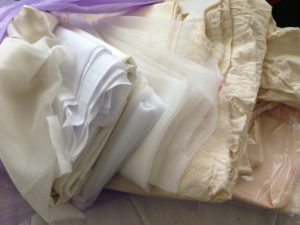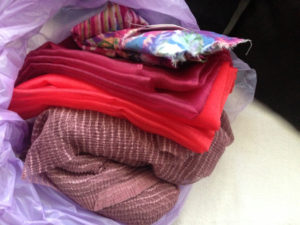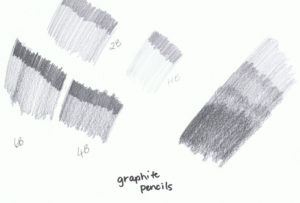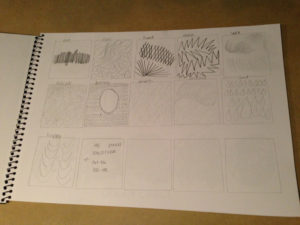Submitted by AliaK on Mon, 05/08/2013 - 11:44
A Creative Approach — Project 2 Developing your marks — Stage 2 — Exploring marks and lines through stitch techniques
For this exercise, I started with machine embroidery. I dropped the feed dogs and put the fabric into the hoop, but I had to remove the footer each time I had to start sewing. The first stitch I tried, the machine just sewed on the same spot — almost like satin stitch. I found it really hard to move the fabric around. So I ended up taking the fabric out of the embroidery hoop, lifting the feed dogs again and sewing normally. This time I used red thread so it's easier to see the stitches (the first exercise was off-white on cream calico so is harder to see the stitches clearly). I didn't have any other machine threads of different weight to try the hand wound bobbin.
I made some parallel lines, moving closer together until they made a solid area (albeit small solid area!)
and I tried some circles, though they're a bit wonky. I also tried some "squaretooth" stitches as I liked the shape of these. I must have a tension issue as there's a bit of puckering of the fabric where the stitches have pulled the fabric around the stitches. I did try different stitch lengths. When I did the test swatches I found that tension=3 was the best setting, so I kept this the same for all the stitchings
Front side of the fabric:
Submitted by AliaK on Sun, 04/08/2013 - 11:41
A Creative Approach — Project 2 Developing your marks — Stage 1 — Preparation
The first stage of this exercise was to sort my fabric stash into bags. I chose to separate them by colour. There are a couple of crossovers with the greens/browns.




Submitted by AliaK on Fri, 02/08/2013 - 11:38
A Creative Approach — Project 1 Marking marks — Stage 4 — Working from your sketchbooks — review
Review questions
Submitted by AliaK on Tue, 30/07/2013 - 11:36
A Creative Approach — Project 1 Marking marks — Stage 3 — Exercise 2 — Using marks to create surface textures
This exercise involved recreating the textured surfaces of objects.
This first page has a drawing trying to replicate the texture of patio tiles, and another showing the branches and remaining leaves of a tree that had lost its leaves during winter — as viewed from the patio whilst looking across the garden. I painted the watercolour wash over the ink drawing in the evening, and thought I was using a brownish grey colour but when I checked in the light of day the next day, I'd actually used a purple colour. Oops. So the colours are not 100% accurate but hopefully the feel of the texture shows through:


Submitted by AliaK on Tue, 30/07/2013 - 11:23
A Creative Approach — Project 1 Marking marks — Stage 3 — Exercise 1 — Using marks to create surface textures
This exercise involved using marks to create surface textures — working from visual sources.
For these exercises I used pages from a magazine - "belle" magazine, june/july 2013
This first one is trying to replicate the textured rug, using graphite and charcoal pencils:


Submitted by AliaK on Tue, 16/07/2013 - 11:20
tonight I was reading through class notes again and just realised I have more to do for assignment one than I thought. I'd totally missed a whole section - project 2. I was thinking project 1 = assignment 1 :(
in other news, I came across this article / project tonight which I thought might fit with my theme of code/encryption (perhaps not glitch). Anti-loneliness augmented quilt comforts children in hospital. from Joshua Barnes' site:
"As a means to combat symptoms of loneliness experienced by children staying long periods of time in hospital, the Augmented Quilt opens up an additional line of communication between the child and their loved ones. Each animal illustration on the quilt can be linked to a friend or family member, who can in turn leave digital messages for the child to read using a smart device. This highly personal form of communication is more meaningful to the child than anything a facebook message alone is capable of. Simultaneously the intimate tactile nature of the quilt also serves as a physical source of comfort which, when combined with the personal messages, provides a greater sense of security to the child in what is a potentially distressing time."
Submitted by AliaK on Mon, 15/07/2013 - 13:40
tonight I watched videos on Zandra Rhodes' tutorial page on her website. the first video about Sketchbooks was great. I liked how she speaks on photographs vs drawing in sketchbooks: "to me, i never get to know something unless I've drawn it & suffered it"
there's also some great videos on screenprinting and making the prints for some of her fabrics. it's interesting that she uses layout paper for her sketchbooks too - I might have to try that for the pens
[embed]https://vimeo.com/58172850[/embed]
Tutorial 1 Zandra Rhodes: Using sketchbooks from UCA Learning Technologists on Vimeo.also I started reading through "Indigo - The Colour that Changed the World" by Catherine Legrand, after finding it at Potts Point bookstore yesterday. I've almost bought this book a few times online, but hadn't quite pressed submit on the order. it's a visual feast - interesting to learn more about indigo following the shibori class I did a few weeks ago.
and, a non-art-textiles related article to read is, "In Conversation with Adam Curtis, Part I" by (one of my favourite curators) Hans Ulrich Obrist - they do speak about art in the article
Submitted by AliaK on Sun, 14/07/2013 - 13:36
today I went to the Art Gallery of NSW and saw "The Sydney Moderns" exhibition. I loved the "colour music" works of Roy de Maistre - I think these would translate well to textiles. like weaving sounds and colour. he did a lot of work based on synaesthesia. I was at the gallery with my sister and 10 month old niece, who was very excited - singing and dancing in the gallery - so we walked quickly through the exhibition so as not to disturb others viewing the works. I hope to go back and see it again and spend some more time looking at the paintings. De Maistre also did some paintings based on the colour wheel.
Submitted by AliaK on Fri, 12/07/2013 - 13:29
I've been reading and browsing through the book, "Drawn to stitch - Line, drawing and mark-making in textile art" by Gwen Hedley. she has some great examples and suggestions for mark-making, which I hope to try. the first part of the book talks about how to describe lines and mark-making. adding the info here so I remember to use it when describing some of my explorations - so far I've only uploaded the pictures, not written much about them.
from pages 9-11. "Drawn to stitch - Line, drawing and mark-making in textile art" by Gwen Hedley
Line
think about characteristics and qualities of lines
are the lines:
- straight, curved, varied?
- geometric or contoured?
- man-made or organic?
- continuous or broken?
- jagged or even?
- dotted, dashed or both?
- thick, thin or varied?
- raised or recessed?
surface colour
are the colours:
- pure or blended?
- muted or grey and dusty?
- bright or subdued?
- solid or broken?
- are the edges soft or hard?
- are there layers of colour? if so, what is the colour order?
textural qualities
is the surface texture:
- smooth or rough?
- varied?
- shiny or dull and matte?
- flat or knobbly?
- complete or eroded?
- rigid, gritty, or sleek?
- opaque, transparent or translucent?
Submitted by AliaK on Wed, 10/07/2013 - 13:26
I've started reading a book by Victoria Finlay called "Colour: A Natural History of the Palette" where she travels and describes how some colours in art have been lost, beginning with a memory of her father telling her how the blue used in the stained glass windows in Chartres is no longer available. (some other sites now say it hasn't been lost). I found an audio interview with Finlay on the ABC website.
yesterday I saw an article called "The Colorful Stories of 5 Obsolete Art Pigments" which describes five pigments which have disappeared from art: Maya Blue, Tyrian Purple, White Lead, Lapis Lazuli, Dragon’s Blood with an update of another three: Mummy Brown, Indian Yellow, Scheele’s Green. the article is continued in another article, "More Vibrant Tales of Obsolete Pigments".
Submitted by AliaK on Mon, 08/07/2013 - 13:24
A Creative Approach — Project 1 Marking marks — Stage 2 — Exercise 4
This exercise involved making marks with many other types of materials.
Block printing — a wine bottle box + softdrink bottle cap with ink stamp pad:

Layers of coloured water based oil pastel crayons with scratchings using a bamboo pen:
I like this one - the colours peeking through seem quite electric - almost neon. I think it's because of the surrounding black colour making them 'pop'

Submitted by AliaK on Mon, 08/07/2013 - 13:19
A Creative Approach — Project 1 Marking marks — Stage 2 — Exercise 3
This exercise involved repeating exercise 1 using a wider range of materials — paints, coloured pencils, crayons, sticks, brushes, sponges, etc.
Submitted by AliaK on Sat, 06/07/2013 - 13:17
I've been thinking about what to use for my theme/s - am not sure if they'll fit yet, but here's my initial ideas:
1. encryption/code/glitch - I've read about women who've (over the centuries) added codes to their fabric to send messages to others - encrypted messages in textiles. it fits in with my work too (encrypted digital tv signals/video/audio). and glitch maybe due to something Jack spoke about (how he likes glitch in video but I try to remove it/prevent it at work - so a balance between work & home) & another class I did & the music equipment/making anomolies that turn out to be something beautiful/special/unplanned - the glitches in the code, the mistakes. I've made some (very rough) video art using glitch over the years, so thought it might fit in
2. sound art/experimental music (maybe dance music culture, hip hop too) - not really sure how I'll fit this in yet, but it's another thing I write on, so trying to think of a way to fit it in - it might end up just being a separate project & I use the things in #1. maybe the music part of it - I think a lot of experimental music/sound art could be converted to embroidery - the lines & patterns & feel of the music into colours and lines.
Submitted by AliaK on Tue, 16/04/2013 - 13:13
A Creative Approach — Project 1 Marking marks — Stage 2 — Exercise 2 — Making marks in an expressive way
This exercise involved using different pencils to show 3 areas of tones — dark, medium, light.
I used a mixture of graphix and graphite pencils of different grades.


Submitted by AliaK on Mon, 08/04/2013 - 13:07
A Creative Approach — Project 1 Marking marks — Stage 2 — Exercise 1 — Making marks in an expressive way
Stage 2 - Exercise 1
Making marks based on the words: fast, slow, hard, sharp, soft, delicate, bumpy, smooth, sensuous, sad, happy using a variety of pencils
The first exercise we had to make marks using the theme words. I did this in my A3 book. For this exercise I used an HB pencil, charcoal, and a watercolour pencil
For the first page, I tried one square for each word:

Then I changed to using one A3 page per word for a few selected words.
fast:

slow:

Pages